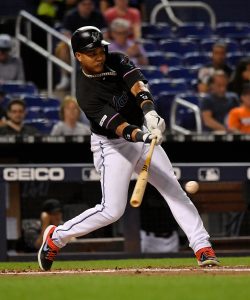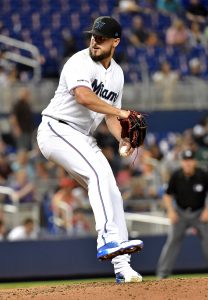Apart from a few scattered signs of promise dotting the South Florida tank, it’s been another year to forget for the Fish. The Marlins currently sit at 32-54, 19.5 games back of the Braves in a tough NL East, a mark that all but assures the club of a decade-long losing-season sweep.
The club’s heaviest assets of yesteryear have all been pawned, leaving an assortment of pre-arb castoffs, up-and-comers, and journeymen hangers-on. Still, it’s baseball, and where playing time awaits, new assets will emerge. The club has steadily rebuilt its once-barren farm, stolen a couple names from regimes with which new club personnel were familiar, and allowed previously cast aside young talent to flourish. Even Zac Gallen and Sandy Alcantara, the bulk of the oft-pilloried return for Marcell Ozuna, have spread their wings this season, with the former vaulting into top-100 territory and the latter notching the club’s lone ’19 All-Star appearance despite shaky peripherals.
Can the club add to its array of projected big leaguers on the farm? Many of its top performers this season – Brian Anderson, Pablo Lopez, Garrett Cooper, Caleb Smith – figure to comprise the core of Miami’s next contending club, and are thus unlikely to move. Veterans Martin Prado, Starlin Castro, Wei-Yin Chen, Adam Conley, and Sergio Romo have done little to boost their respective values, and high-octane hurler Jose Urena hasn’t take the step forward the team hoped. But one former throw-in from a long-ago deal has remained steady as always.
Enter Miguel Rojas. Acquired in the head-scratching deal that sent Andrew Heaney, Kiké Hernandez, and Austin Barnes to LA in exchange for Dee Gordon and an aging Dan Haren, Rojas was used sparingly in his first couple seasons with the club. He opened eyes with a 1.4 fWAR performance in just 90 games in 2017, pairing strong contact ability with above-average defense at multiple positions. The gutting of 2018’s roster left near-full-time opportunity at shortstop for Rojas, a position at which he sparkled defensively, notching 10 defensive runs saved in nearly half the innings of NL-leader Nick Ahmed, who posted 21, and a UZR/150 that ranked among MLB’s best.
The 30-year-old Venezuelan has vaulted up a notch this season, pacing the big leagues in both UZR/150 and the range component of the stat, with a striking 13 Defensive Runs Saved to boot. With Andrelton Simmons on the shelf, and Brandon Crawford looking a shell of his former shelf all across the diamond, Rojas has staked a legitimate claim to the league’s best defender at the most difficult defensive position on the field.
His bat, too, has taken off: his 97 wRC+ has the one-time utility man on pace for nearly 3.0 fWAR this season, an easily above-average mark, and his second such offensive campaign in three years. His hard-hit rate has jumped to a career-high 35.5%, and the righty’s chasing pitches outside the zone at a career-low pace. Rojas’ 12.8 K% (paired with a respectable 7.8% BB) ranks among the league’s lowest.
In short, he’s as solid as they come. But where will he fit? Unlike other positions – catcher, second base – shortstop is rife with talent, and nearly every contender has a good one. Milwaukee, who’s seen Orlando Arcia reprise his poor performance from a season ago, could be a fit, as might Tampa or perhaps Pittsburgh or Cincinnati. Washington could again shift its shortstop, Trea Turner, around the diamond – he’s been awful defensively in limited action so far this season – as could the Cubs, whose second-base hole might simply be plugged by the displacement of one-time incumbent Javier Baez.
Given the propensity of new-wave front offices to acquire pieces without a clear fit, it stands to reason that Rojas’ market may be wider than it first appears. He’s arbitration-eligible for the final time in 2020, so Miami’s return won’t be negligible; the one-time throw-in may soon find himself a centerpiece.

